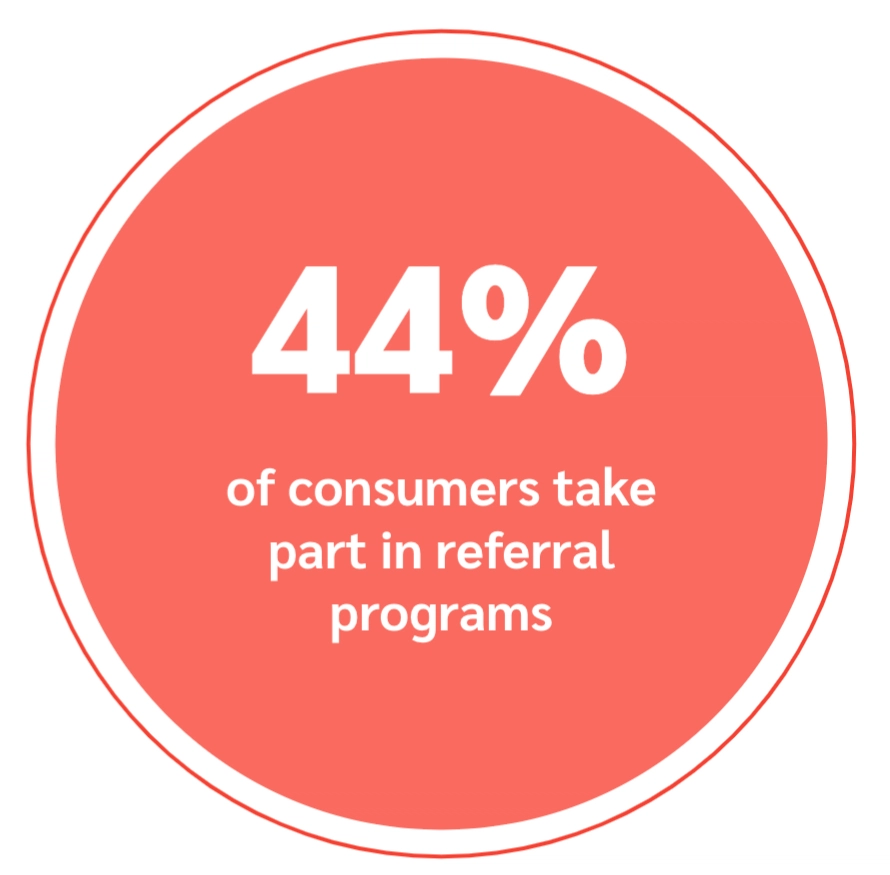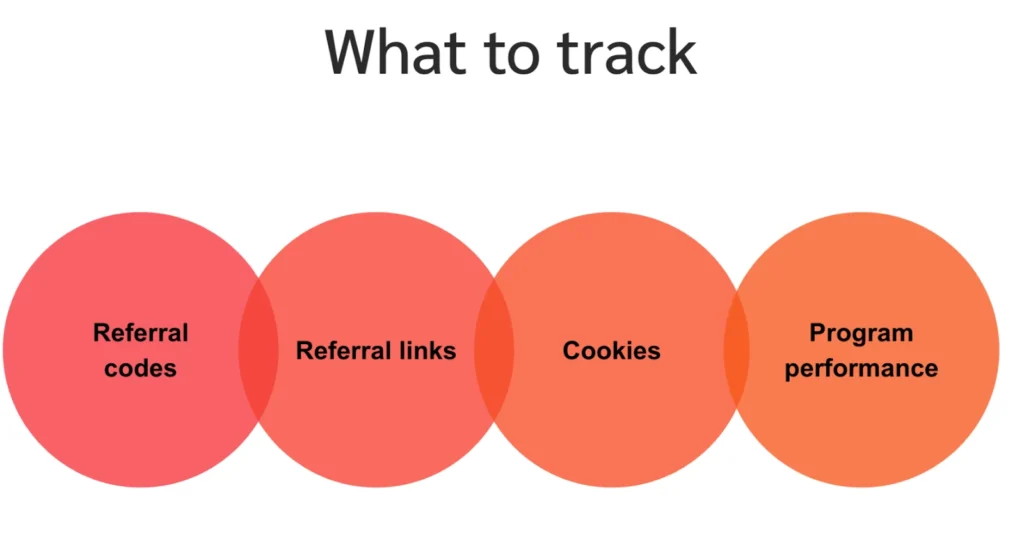Remember that scene in Mean Girls where Gretchen Wieners tries to make ‘fetch’ happen? Referral marketing also works hard to create hype. But instead of forcing trends, businesses influence conversions by encouraging happy customers to naturally spread brand awareness.
Think of referral tracking as your word-of-mouth detective—revealing which customer champions are sending you qualified leads, which messages convert best, and where your referral funnel might be leaking. With the right tracking system, fuzzy anecdotes transform into actionable data.
But not all tracking tools are created equal. Some excel at fraud prevention, others at reward automation, and still others at analytics. Let’s cut through the noise and pinpoint exactly which features matter most for your specific referral strategy.
What is referral tracking?
Picture this: You’ve turned your happy customers into brand ambassadors, but without a system to track their impact, you’re essentially flying blind. That’s where referral tracking comes in.
At its core, referral tracking is your radar system for word-of-mouth marketing. It monitors who’s recommending your brand, which recommendations actually convert, and what messaging resonates most powerfully. Think of it as the difference between throwing darts blindfolded versus with perfect vision—suddenly, you can see exactly what works.
By tracking their efforts, you can understand their secret sauce and reward them properly. After all, a customer who brings you five new paying clients deserves more recognition than someone who merely shares a link that nobody clicks.
Why is referral tracking important? The benefits of optimizing and protecting your program
A strong referral program spans across various teams, including marketing, finance, legal, and tech. Without accurate tracking, it’s challenging to stay compliant with FTC regulations. It’s also difficult to optimize performance and ensure advocates get the right incentives. That’s why you need referral tracking.
Here are five reasons why referral tracking is important:
1. Prevents referral fraud
Not every referral is legitimate. Some bad actors exploit referral systems, taking rewards they didn’t earn. Referral tracking spots abuse and fraud, protecting your budget and brand reputation.
Referral tracking helps identify fraud like:
- Multiple self-referrals: An individual uses multiple accounts or devices to earn rewards.
- Fake or duplicate accounts: Duplicate accounts inflate your numbers, without providing the results you’re after.
- Referral code sharing: Posting referral codes in public forums in violation of program rules.
- Bots: Automated scripts that generate fake sign-ups.
- Fake transactions: Fraudulent activity impacts multiple teams within your company.
Identifying and preventing fraud helps protect your brand reputation while maintaining trust with your advocates and new customers.
2. Keeps track of conversions
Referral tracking helps you monitor conversions. It connects the dots to understand which customers sent new customers to your brand.
With referral tracking, you can:
- Identify which referrers drive the most high-quality leads.
- Compare sign-ups to actual paying customers.
- Optimize messaging based on what’s converting best.
- Allocate marketing spend to the most effective referral sources.
Bottom line: Referrals are a key step in the customer journey. Tracking referrals helps you pinpoint where leads convert—or drop off— so you can refine your approach and adjust funnels.
3. Helps you identify super fans
Some advocates go above and beyond for your brand. Referral tracking helps recognize your super fans, who drive the highest number of engaged, high-value customers.
Identifying super fans helps you better understand their audience demographics and behavior. By analyzing this information, you can:
- Strengthen relationships with your best advocates.
- Form official partnerships with top referrers (creators, affiliates, publishers, etc).
- Fine-tune your messaging to better engage their audience.
Not only does referral tracking find your most enthusiastic fans, but understanding what makes top advocates successful lets you strategically scale your program.
4. Gives you the ability to reward the right advocates
One of the biggest reasons customers recommend brands is to receive incentives. In fact, most of the 44 percent of consumers who participate in referral programs, do so to earn rewards.

Source: Customer referral marketing research: A consumer perspective
Whether it’s discounts, exclusive brand perks, or free products, brands should reward based on customer contributions and preferences.
Whatever you offer, referral tracking ensures rewards go to the right people at the right time. Plus, it helps you stay organized and track which advocates qualify for a bigger bonus.
5. Enhances customer acquisition
When your customers voluntarily become salespeople, you’ve struck marketing gold. But which advocates are sending you qualified buyers versus tire kickers? This is where strategic tracking transforms random referrals into a predictable growth engine.
With proper referral tracking, patterns emerge—suddenly you can see which customer segments, message types, and channels consistently deliver your highest-value customers. Armed with this intelligence, you can:
- Double down on referral campaigns with proven ROI instead of spreading resources thin
- Pivot quickly from underperforming strategies instead of watching them drain your budget
- Create a self-improving system where each referral makes your program smarter
The difference? Turning occasional customer goodwill into a systematized acquisition channel that delivers predictable results quarter after quarter.
Methods of referral tracking
Word-of-mouth strategies rely on discount codes, special links, or forms to connect new customers to their audiences. Use an efficient tracking system to stay organized and increase growth.
Brands typically use one of two methods: manual tracking and automated tracking.
Manual vs automated referral tracking: which works best?
Manual tracking starts innocently enough—a simple spreadsheet, a few dozen referrals, what could go wrong? But as your program grows, so does the administrative nightmare.
Picture this: Your marketing coordinator spends hours each week copying referral data, matching transactions, calculating rewards, and emailing confirmations. Meanwhile, that high-value customer who referred three friends last week is still waiting for acknowledgment because the spreadsheet hasn’t been updated yet.
The true costs of manual tracking are insidious:
- Data entry errors that leave customers unrewarded or rewards duplicated
- Delayed insights that arrive too late to save failing campaigns
- Team members who could be building relationships spending their time reconciling numbers instead
- Your most valuable advocates growing frustrated with slow recognition
Automation changes the game entirely. Your system captures each referral as it happens, instantly attributes it to the right advocate, and triggers appropriate rewards—all while building a real-time performance dashboard no spreadsheet could match. Your team shifts from data entry to strategy, and your program scales without adding headcount.
For example, Jobber transitioned from manual referral tracking to impact.com/avocate’s automated referral system. The result? A 4.86% higher lifetime value for referred versus non-referred customers.
Automated systems reduce manual tasks, leaving your team more time to strengthen relationships with brand advocates and create messaging campaigns that drive results.
Setting up referral tracking systems
Setting up referral tracking doesn’t need to be complicated. You just need the right tools and a system that fits your brand and goals. Whether you have a handful of advocates or a large program, tracking who sends you leads is crucial to rewarding the right people.
Here’s how to set up referral tracking:
1. Choose your tracking method:
Pick between manual or automated tracking. As mentioned above, manual tracking may be sufficient for very basic programs. It requires simple tools, like Google Analytics, unique referral codes or UTM tags, and a spreadsheet.
Automated tracking is the preferred method of tracking for brands with more mature referral programs.
For example, RealtyNinja started with a manual system, but as their program grew, it became difficult to maintain and scale the program. The brand switched to impact.com’s automated tracking and offered customers a sweet discount on their subscriptions for each referral. The results:
- 16 percent of new users came from referrals.
- 136 percent higher conversion rates compared to free trials.
- Double the conversion rate from referrals compared to paid ads
2. Create unique referral codes and links
Unique referral codes are the key to making referral tracking work. Without them, determining which brand advocate sent you new leads is impossible.
Assign each advocate a custom code or link that’s easy to use and remember. Codes can be added to UTM parameters. This lets you attribute traffic and conversions directly to the referrer.
3. Enter unique referral codes and links into your system
For manual tracking, pop your links into Google Analytics. Using the dashboard and insights, you’ll get a good idea of where your leads come from.
If you’re using referral software, add your links to the platform. These tools make it easy to automate processes, like tracking clicks, conversions, and rewards, without manual labor.
The importance of referral tracking software: How to choose the best one for your business needs
Investing in the right referral tracking software saves your brand time, reduces errors and challenges, and maximizes performance. However, not every solution is the right fit for every brand.
When evaluating referral tools for your brand, consider these five must-have features:
1. Advanced flexibility and scalability
The most successful referral programs adapt over time. You might offer cash rewards one month, and the next month exclusive early access to new products. Your software should make these pivots effortless, not engineering projects.
Look for flexibility in three critical areas:
- Reward flexibility that lets you experiment with different incentive types without code changes
- Program settings you can adjust yourself as you learn what works best for your audience
- Customization options that make the referral experience feel like a natural extension of your brand, not a bolted-on afterthought
The best platforms strike that delicate balance—powerful enough to accommodate your growing ambitions, yet intuitive enough that your team can make changes without calling IT support every time.
2. Fraud detection and prevention
Cybercrime is rising, with projected losses reaching over $13 trillion by 2028. A referral program with built-in fraud detection helps safeguard your program.
Key fraud prevention features include:
- Automated detection of duplicate names, emails, and IP addresses.
- Suspicious activity monitoring to flag unusual patterns.
- GDPR compliance to protect customer data and trust.
Fraud detection and prevention is a critical feature that shouldn’t be overlooked.
3. Comprehensive reporting functions
Basic tracking tells you how many referrals you received, but sophisticated analytics reveal the story behind the numbers.
A powerful analytics dashboard transforms raw data into actionable intelligence:
- Instantly spotlights your referral MVPs—those rare customers whose recommendations consistently convert
- Reveals hidden patterns like which days yield the most valuable referrals or which messaging resonates with specific customer segments
- Flags potential issues before they become problems, like declining conversion rates from previously reliable channels
The difference is dramatic: Instead of wondering why referrals dipped last month, you’ll know exactly which campaign changes affected performance and how to course-correct immediately. Instead of guessing which advocates to nurture, you’ll see precisely who drives the highest customer lifetime value.
4. Integration capabilities
Don’t build a marketing island. Integration capabilities aren’t just a nice-to-have—they’re the foundation of an effective referral system. Before you invest in referral software, ensure it plays nicely with your existing tech stack. Think about these three things:
- Your CRM
- Ecommerce platform
- Payment systems
Integrated tracking makes automation more manageable, and ensures a better customer experience for brand advocates and internal teams.
5. Automated and efficient workflows
Manual processes slow you down. Plus, it leaves room for human error. The best referral software automates critical workflows, like:
- Reward payouts
- Referral validation
- Data syncing across systems
Automation reduces the number of manual tasks your team handles. It also allows your brand to scale your program easily, without overwhelming your teams.
What to track in your referral program
A comprehensive referral tool provides your team with a goldmine of helpful information, but only if you track the right metrics.

Here’s a breakdown of what you should monitor:
1. Referral codes
Think of referral codes as digital breadcrumbs. These unique identifiers are the simplest way to trace who’s sending business your way. When implemented correctly, each advocate gets their own distinctive code to share with friends and colleagues.
The magic happens when a potential customer enters this code during signup or checkout. Instantly, your system attributes this lead to the specific advocate who made the recommendation. No guesswork required.
Many brands supercharge these codes by making them dual-purpose—not just tracking tools, but also discount triggers that reward the referred customer with savings on their first purchase. This creates a win-win scenario where both parties benefit from the referral.
Pro tip: If you’re using expiration dates to create urgency, implement a management system to track active versus expired codes. Nothing frustrates a potential customer more than trying to use a referral code only to discover it’s no longer valid.
2. Unique referral links
Unlike codes that customers must remember and manually enter, referral links do the heavy lifting automatically. One-click and the referral is tracked—no extra steps to worry about.
These custom URLs contain embedded tracking parameters that instantly identify which advocate sent the visitor your way. When Sarah shares her unique link on social media and Mark clicks it to reach your landing page, your system immediately knows Sarah deserves credit for that potential customer—even if Mark takes weeks to complete a purchase.
Sharing links is effortless for advocates, the journey for leads is seamless, and attribution is automatic for your marketing team. It’s a tracking method that removes barriers at every step.
3. First-party cookies
While third-party cookies face increasing restrictions, first-party cookies remain marketing gold—collecting valuable behavioral data without crossing privacy boundaries.
These small data packets track how referred visitors interact with your site—which pages they visit, how long they stay, and what ultimately converts them. This intelligence helps you refine your referral funnel with precision: discovering that customers referred from your loyalty program spend 40 percent more time exploring product pages, while social media referrals convert fastest on mobile devices.
Remember to maintain transparency about your data collection practices. A clear cookie notice not only keeps you compliant with regulations like GDPR and CCPA, but also builds trust with privacy-conscious consumers who appreciate your straightforward approach.
4. Overall program performance
One of the most critical aspects to track is the performance of your referral program. A poorly performing program can waste time and frustrate you and your customers.
Instead, track metrics like:
- The number of people who saw your referral program
- The number of successful referrals completed
- Revenue generated
- Average lifetime value of referred customers
You’ll also want to track metrics directly related to your customer advocates. Consider tracking:
- Number of active referrers
- Frequency and amount of referrals
- How many referrals they’ve started
- Who they’ve referred
- How many referrals they’ve completed
- How many rewards they earned
Collecting this data can inform your marketing strategy and improve your referral program, making it a worthwhile investment for your brand and customers.
Improve referral tracking for long-term success
Referral tracking is a key component of word-of-mouth campaigns. From preventing fraud and creating trust, to tracking conversions, and rewarding advocates for their efforts, a tracking system ensures every customer recommendation counts.
Investing in the right referral tracking software for your business is a must. It simplifies the process, saves time and resources, and enhances customer acquisition.
With software like impact.com/advocate brands can easily manage programs, track leads in real-time, and stay on top of rewarding customers for participation.
Want to learn more about how customer referral and loyalty strategies can grow your business? Check out these resources:
- How to win back lost customers: 7 marketing tactics that rebuild customer loyalty [blog]
- 5 successful ecommerce referral programs and why they work [blog]
- How to switch to a new referral platform in 6 easy steps [blog]
- Top 6 customer referral marketing trends your brand can leverage in 2024 [blog]
- 7 referral marketing strategies to grow your retail business [+stand-out brand examples] [blog]
- Turn delighted customers into revenue-driving advocates [ebook]
- More than a pop-up: Building a customer referral program that scales [+ the tech that drives it [blog]
FAQs:
Referral tracking is the process of monitoring and analyzing the results of referral marketing campaigns to measure success and optimize performance. It helps brands understand which customer advocates send them qualified leads, while also tracking program performance.
You can manually track a referral program by using spreadsheets and simple tools. However, as a referral program grows, an automated tracking system helps streamline the process, save time, and reduce errors.
While referral tracking and affiliate tracking are similar, they aren’t the same. Referral tracking analyzes customers referred by existing customers. On the other hand, affiliate tracking monitors recommendations generated by third-party partners, such as affiliates, influencers, publishers, and other businesses.
Start by generating unique referral codes or links for each partner. For manual tracking, store these in a spreadsheet or database for easy access. If you’re using a CRM or a platform like impact.com, you can automate tracking, monitor conversions, and issue rewards with minimal manual work. For both manual and automated tracking, use UTM parameters or custom URL slugs to track clicks, signups, and purchases tied to each code.
There are two main types of referral tracking: manual and automated. Manual tracking can be simple or detailed, often using a spreadsheet and a tool like Google Analytics to monitor traffic and conversions. Automated tracking like impact.com let you easily generate referral links or codes, track performance, and issue rewards in real-time.






